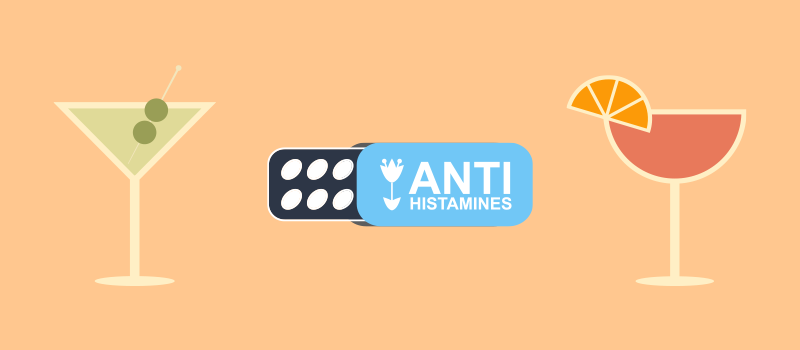Antihistamines are generally considered safe medications. They rarely cause severe complications and are widely used for allergies, colds, and hay fever. However, many people mistakenly assume they can be combined safely with alcohol. In reality, mixing antihistamines with alcoholic drinks can be harmful, since both act as central nervous system (CNS) depressants.
How Antihistamines and Alcohol Affect the Body
Some prescription and over-the-counter (OTC) antihistamines can cause strong sedation on their own. When alcohol is added, even in small amounts, the side effects intensify. This combination can lead to:
- Slowed central nervous system activity
- Sedation and drowsiness
- Dizziness and lack of coordination
- Reduced concentration
- Blurred vision
- Dry mouth and thickened mucus
- Nausea and upset stomach
The main risk is excessive drowsiness and impaired motor skills, which makes driving or performing critical tasks extremely dangerous. In some cases, combining alcohol with certain antihistamines can also lower blood pressure.
According to the NIAAA (National Institute on Alcohol Abuse and Alcoholism), mixing alcohol with antihistamines may also trigger vomiting, headaches, and extreme fatigue. When alcohol is combined with sedatives like Xanax, the dangers multiply — slow breathing, irregular pulse, coma, and even death.
The National Highway Traffic Safety Administration notes that antihistamines alone can impair driving ability more than alcohol. Adding alcohol makes the risks even greater.
⚠️ Even unrelated medications like azithromycin, when combined with alcohol, may cause similar side effects.
Statistics on Antihistamine and Alcohol Use
- In 2017, nearly 20 million U.S. adults were diagnosed with hay fever, and another 8 million reported respiratory allergies. Most were prescribed or self-medicated with antihistamines.
- Around 85% of Americans have consumed alcohol at least once in their lifetime.
- A 2016 study tested the antihistamine mequitazine with and without alcohol during real traffic driving. While the drug alone caused no major driving impairment, combining it with alcohol significantly worsened performance and reaction times.
Antihistamines and Alcohol-Containing OTC Medications
Many cold and flu medicines contain small amounts of alcohol and are sometimes combined with antihistamines. While the alcohol content is usually low, patients should always inform their doctor about all medications they are taking.
In rare cases, even small amounts of alcohol with antihistamines can cause:
- Extreme drowsiness
- Impaired motor skills
- Fatigue
- Reduced concentration
Steroids, which are sometimes prescribed for hives, should also not be mixed with alcohol, since both suppress the immune system.
Does Alcohol Affect Antihistamine Effectiveness?
Yes. Alcohol can interfere with antihistamines, especially older-generation ones, making side effects like sleepiness stronger. Because both alcohol and many drugs are metabolized in the liver, combining them increases the risk of harmful interactions.
Antihistamines for Asian Alcohol Flush
Some people experience Asian Flush — facial redness after drinking alcohol. While some believe antihistamines like Zantac can reduce flushing, experts warn this is unsafe. According to researchers at USC, combining alcohol with antihistamines may increase the risk of:
- Stomach cancer
- Skin cancer (squamous cell carcinoma)
- Esophageal cancer
Studies also show that this combination raises blood alcohol levels and impairs psychomotor skills, outweighing any cosmetic benefit.
What to Do If You’re Taking Antihistamines
- Avoid alcohol while on antihistamines, even if the medications are OTC.
- Be cautious with cold medicines, mouthwashes, or other drugs that may contain alcohol.
- Remember: the interaction can still occur even if the antihistamine and alcohol are not taken at the exact same time.
If you struggle with alcohol use, it’s best to seek professional help. Treatment options include inpatient and outpatient rehabilitation, behavioral therapy, and holistic approaches that support long-term recovery.
